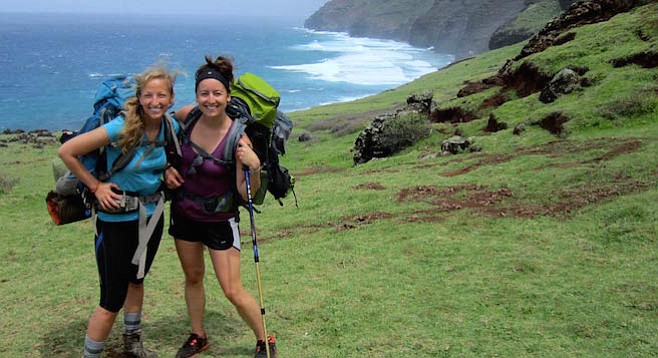 Facebook
Facebook
 X
X
 Instagram
Instagram
 TikTok
TikTok
 Youtube
Youtube

A 1972 state proposition mandated a public walking path spanning the California coast, but to this day the trail has not been finished. To raise awareness of the need for improvements, marine scientists and trail ambassadors “Mo” Visalli and Jocelyn “Jo” Enevoldsen are hiking from the Oregon border to the border with Mexico. On the way they are also producing content and checking the route for a soon-to-be-released California Coastal Trail app.
Funded by a fellowship from the California State Coastal Conservancy, the 1200-mile MoJo Coast Walk began in May and will end with a celebration at Border Field State Park on Thursday, August 4. The hikers passed through Scripps campus in La Jolla on August 2, where a small crowd gathered on the beach to greet them. Scripps recently added a sweeping wooden staircase, railings, benches, signage, and native plantings to the trail portion that runs through campus and past the pier. There is also a one-hour parking space reserved for visitor access.
Enevelodsen said the California Coastal Trail build-out is about one-half to two-thirds complete, while in some places the location is still uncertain. The two had to take a bike detour inland to get around Vandenberg Air Force Base, on the central coast, where access to the beach does not exist. They skirted Camp Pendleton by riding down I-5. In San Francisco they walked across the Golden Gate Bridge.
But much of the journey was foot-in-sand or hoof-to-bluff where the steep California cliffs meet the Pacific. On the Lost Coast, a portion of Mendocino and Humboldt counties that has no direct road access, the pair was hiking along the tide pools when they came face-to-face with an otter. Startled by their presence, the otter dropped the lingcod it was holding and stared at them for a few seconds. As the meal started to slither back to the safety of a shallow pool, the otter lunged after it and snatched it back up, forgetting the two humans in favor of dinner. They watched as the otter ate its catch.
Mobile van support followed Mo and Jo with food and medical supplies. They camped or lodged along the way, sometimes staying with community members who welcomed them into their homes. In Northern California they were laden with bulky bags of extra clothing and blankets, while in SoCal they shed the heavy loads for the comfort of bikinis and daypacks.


A 1972 state proposition mandated a public walking path spanning the California coast, but to this day the trail has not been finished. To raise awareness of the need for improvements, marine scientists and trail ambassadors “Mo” Visalli and Jocelyn “Jo” Enevoldsen are hiking from the Oregon border to the border with Mexico. On the way they are also producing content and checking the route for a soon-to-be-released California Coastal Trail app.
Funded by a fellowship from the California State Coastal Conservancy, the 1200-mile MoJo Coast Walk began in May and will end with a celebration at Border Field State Park on Thursday, August 4. The hikers passed through Scripps campus in La Jolla on August 2, where a small crowd gathered on the beach to greet them. Scripps recently added a sweeping wooden staircase, railings, benches, signage, and native plantings to the trail portion that runs through campus and past the pier. There is also a one-hour parking space reserved for visitor access.
Enevelodsen said the California Coastal Trail build-out is about one-half to two-thirds complete, while in some places the location is still uncertain. The two had to take a bike detour inland to get around Vandenberg Air Force Base, on the central coast, where access to the beach does not exist. They skirted Camp Pendleton by riding down I-5. In San Francisco they walked across the Golden Gate Bridge.
But much of the journey was foot-in-sand or hoof-to-bluff where the steep California cliffs meet the Pacific. On the Lost Coast, a portion of Mendocino and Humboldt counties that has no direct road access, the pair was hiking along the tide pools when they came face-to-face with an otter. Startled by their presence, the otter dropped the lingcod it was holding and stared at them for a few seconds. As the meal started to slither back to the safety of a shallow pool, the otter lunged after it and snatched it back up, forgetting the two humans in favor of dinner. They watched as the otter ate its catch.
Mobile van support followed Mo and Jo with food and medical supplies. They camped or lodged along the way, sometimes staying with community members who welcomed them into their homes. In Northern California they were laden with bulky bags of extra clothing and blankets, while in SoCal they shed the heavy loads for the comfort of bikinis and daypacks.
Comments